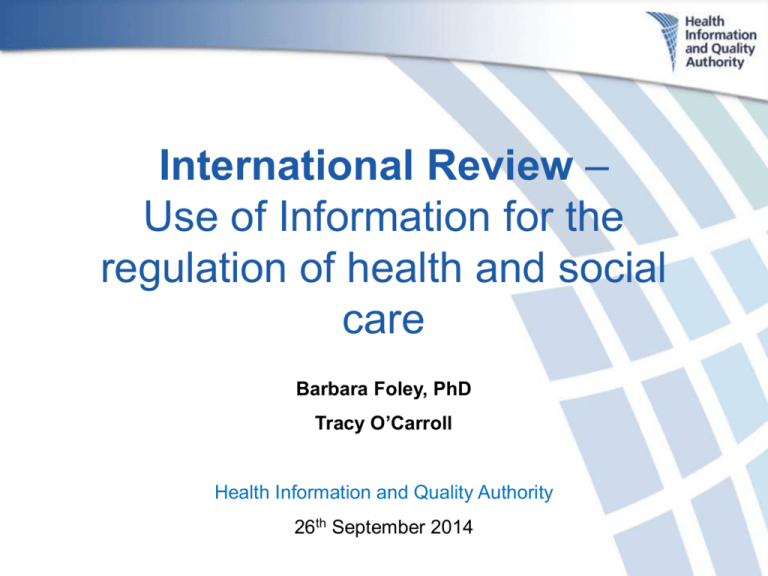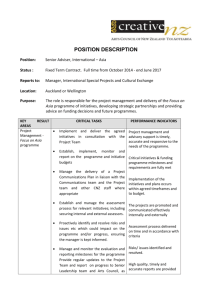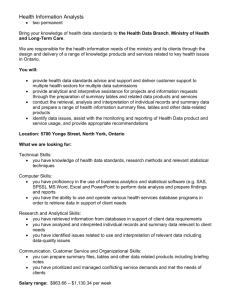Health Quality Ontario
advertisement

International Review – Use of Information for the regulation of health and social care Barbara Foley, PhD Tracy O’Carroll Health Information and Quality Authority 26th September 2014 Presentation overview Part 1 Background Methodology Use of information for regulation Part 2 Quality indicators Tools to inform quality of care Reporting Objective Conduct international review to identify how regulators and health improvement agencies use data to improve health and social care. About HIQA To drive continuous improvements in the quality and safety of health and social care in Ireland Setting Standards Supporting Improvement Monitoring Quality and Safety in Healthcare Inspecting Social Services Health Technology Assessment Health Information Technical Standards Health Information Quality Business Intelligence Jurisdictions reviewed New Zealand Ontario, Canada England Netherlands Denmark Scotland Wales / N.Ireland (summary) Consultation with key individuals Jurisdiction Organisation Name Title New Zealand Health and Quality Safety Commission Richard Hamblin Director of Health Quality and Evaluation New Zealand Ministry of Health Caroline Boyd Manager, Strategy and Policy Director of Evaluation and Research Ontario, Canada Health Quality Ontario Gail Dobell Ontario, Canada Health Quality Ontario Wiser Haj-Ali Manager - Performance Measurement & Reporting England Care Quality Commission Neil Prime Head of Analytics England Care Quality Commission David Harvey Team Manager Netherlands Inspectie voor de Gezondheidszorg (IGZ) Perry Koevoets Advisor – Research & Innovation Denmark Danish Health and Medicines Authority Healthcare Improvement Scotland Anne Mette Dons Head of Supervision and Patient Health Executive Clinical Director Healthcare Improvement Scotland Donald Morrison Scotland Scotland Dr Brian Robson Business Intelligence Division Structures in place Country Regulation New Zealand Ministry of Health (HealthCERT) Quality Improvement The Health Quality and Safety Commission (HQSC) Ontario Ministry of Health and Long-Term Care Health Quality Ontario England Care Quality Commission (CQC) Care Quality Commission Netherlands Inspectie voor de Gezondheidszorg Quality Institute ; CBO Denmark The Danish Health and Medicines Agency Danish Institute for Quality and Accreditation in healthcare (IKAS). Scotland •Healthcare Improvement Scotland •The Care Inspectorate Healthcare Improvement Scotland (HIS) Wales •Healthcare Inspectorate Wales (HIW) •Care and Social Services Inspectorate Wales (CSSIW) NHS Wales and Welsh government. Northern Ireland Regulation and Quality Improvement Authority (RQIA) RQIA Key findings (www.hiqa.ie) 1. Vision/Strategy All the countries reviewed had strategic approach in place for the use of information to improve health and social care Information being used as both regulatory and quality improvement tool Changing profile of regulation – increased emphasis on information /intelligence 2. Defining the information Quantitative Qualitative Surveys Patient/staff experience Structured/unstructured Social media Complaints/whistle-blowing Types of indicator data Focus on existing datasets 3. Applying Business Intelligence Clear vision/ action plan around Business Intelligence Key strategic approach to Information and Intelligence Outsourcing of analysis - “Data Partners” Centralised structure Presentation of information “intelligently” interactivity of information / web-based Use of Information - Regulation England (CQC) - New “Intelligent Monitoring”/ Surveillance model for NHS Acute Trusts Netherlands (IGZ)- Risk-led supervision – Proactive - analysis of information provided routinely – Reactive – incident-led; complaints etc Intelligent Monitoring (CQC) Previously – Quality and Risk Profiles (QRPs) for acute hospitals advanced statistical modelling New model - Intelligent monitoring informs programme of inspections (Sept 2013) Clarity about indicators they will prioritise, rather than a model that claims to scan all information all the time Uses local and national information sources 14 Indicators – Intelligent Monitoring Avoidable infections (e.g. MRSA) Notifications of deaths, severe and moderate harm and abuse Never events Mortality rates ‘Your Experience’ form – CQC Patient and staff surveys Complaints Dutch model for risk-led supervision Dutch Healthcare Inspectorate Inspectorate Risk detection System (IRiS) Intelligence data sources Care-related indicators Corporate - Management and finance indicators Incident reports (incidents and near-misses) External signals Own observations/info from other regulators Summary – Part 1 Intelligent monitoring informs programme of inspections Part 2: Indicators Qualitative data – tools to inform quality Reporting and publishing of information Key Performance Indicators (KPIs) Specific and measurable elements of practice that can be used to assess quality of care. Indicators are measures of structures, processes or outcomes that may be correlated with the quality of care delivered. KPIs are not intended to be direct measures of quality but instead act as alerts to warn us of opportunities for improvement in the process and outcome of service-user care. JCAHO Understanding Key Performance Indicators Objective: Improve the quality and safety of care provided Effective: Clear definitions Valid KPIs: Measure what they are intended to measure Reliable KPIs: Consistently produce the same result regardless of who performs the measurement Health Quality and Safety Commission New Zealand GOVERN MEN T GOALS N Z TRIPLE AIM OUTCOMES N ew Zealanders live longer, healthier and more independent lives Improved quality, safety and experience of care N ew Zealand’s economic growth is supported Improved health and equity for all populations Best value from public health system resources Services throughout the patient journey, across the health and disability sector SYSTEM- LEVEL IN DICATORS Safety Measure of adverse events Patient experience Measure of patient experience Effectiveness 2. Amenable (preventable) mortality Functional health outcomes scores Equity Access/ Timeliness Stratification of all measures across population groups Measure of access to primary health care Efficiency 8. Health care cost per capita 9. % GDP spent on health care Measure of w orkforce w ellness CON TRIBUTORY MEASURES Falls resulting in harm in hospitals Healthcare associated infections Measure of surgical harm Measure of safe medication management Pressure injury acquired in hospitals 1. Cancellations of elective surgery by hospital after admission 3. Occupied bed-days aged 75+ admitted tw o or more times per year 4. Day case turns into overnight stay 5. Hospital readmissions Mental heath postdischarge community care Measure of cardiovascular disease management Stratification of all measures across population groups 6. Eligible population up to date w ith cervical screening 7. Ageappropriate vaccinations for tw o- year-olds Hospital days during last six months of life Health Care Ontario Primary Care KPIs Quality and Safety Indicators Avoidable Infections Adverse Events Never events Medication Safety Surgery Hospital Mortality Hospital Activity Disease-specific outcomes Patient experience Complaints Maternity Indicators Social-care specific Structures Patient and Staff Experience All Jurisdictions – all organisations should seek out the patient and carer voice as an essential asset in monitoring the safety and quality of care. A Promise to Learn – a commitment to act. Improving the Safety of Patients in England” NHS: England National Patient Survey Programme The Picker Institute Europe, a private charity, coordinates patient surveys. National NHS Staff Survey in place Patient Experience New Zealand : Health Quality Safety Commission License: use of Picker’s inpatient survey questions, library of 250 questions 4 domains: Communication Partnership Co-ordination Physical and emotional support Adopt an approach comparable with international best practice to allow international comparisons. The National Danish Survey of Patient Experiences (LUP) LUP is conducted under an agreement between the Danish government and the Danish Regions. Survey is conducted by the Unit of Patient Perceived Quality. The unit carries out surveys, research and development projects concerning patient-perceived quality. HEALTH QUALITY ONTARIO Launched pilot survey of patient experience in primary care in 2014 Quality Accounts A report about the quality of services by the service Provider Denmark England New Zealand A statement from the organisation detailing the quality of the services they provide Signed statement from the most senior manager of the organisation Mandatory NHS: Quality Accounts Source: http://www.nhs.uk/aboutNHSChoices/professionals/healthandcareprofessionals/quality-accounts/Pages/about-qualityaccounts.aspx HQSC: Quality Accounts Quality Accounts A Guidance Manual for the New Zealand Health and Disability Sector Corporate and Governance Review Netherlands Annual Social Responsibility report: – – – Management and Finance (liquidity, debt ratio) Personnel turnover Staff absenteeism Structured vs Unstructured Structured vs vs. Unstructured Reports State of the Nation New Zealand, Ministry of Health Health and Independence Report England, CQC The state of health care and adult social care in England in 2012/13 Thematic Læs mere i 'Forebyggelse af indlæggelser synlige resultater' : Prevention of admissions visible results (IKAS) Performance indicators as an independant measure of the quality of hospital care (IGZ) Primary care summary( HQO) Childcare Statistics (HIS) Perinatal and maternal mortality review committee reports (HQSC) Care Quality Commission: Reporting http://www.cqc.org.uk/provider/RTG#icon-keys Health Quality Ontario: Annual Report HQO: AR 2013 Website and displaying information Interactive Dynamic User-friendly Targeted New Zealand: Website and displaying information Health Quality Ontario: Website and displaying information CQC: Website and displaying information Danish Health and Medicines Authority Website and displaying information Summary It is only worth measuring if it changes your practice or the practice of service providers Have clear definitions for indicators Engage as many people as possible in the process A business intelligence strategy is crucial Publish intelligently







